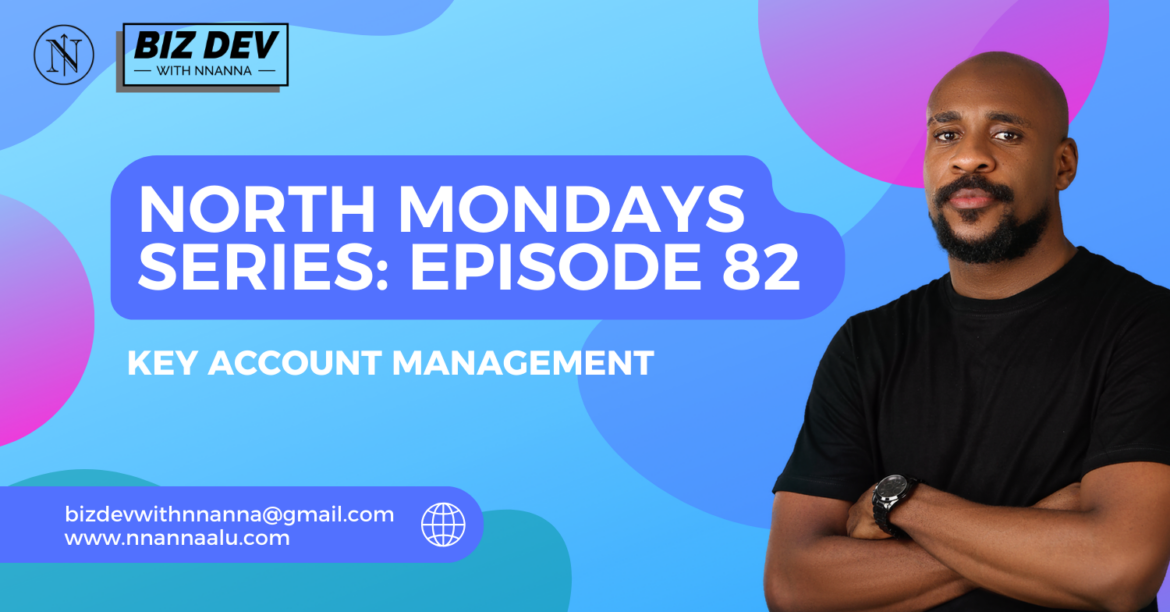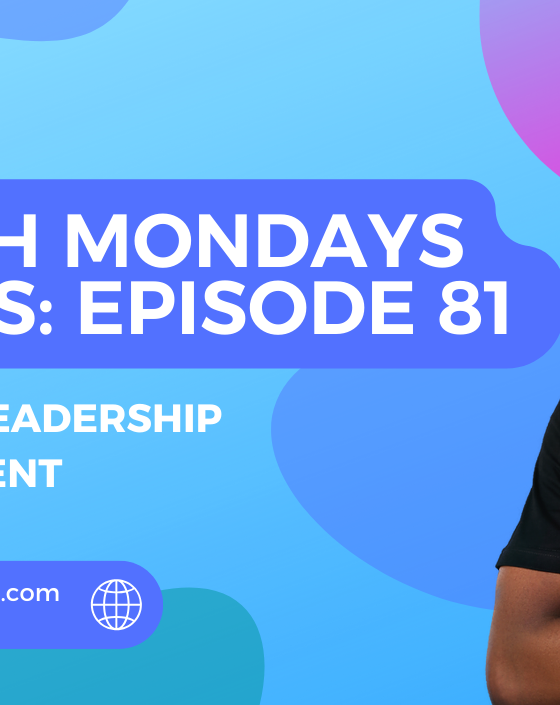Mastering Key Account Management
North Mondays Series: Episode 82

Imagine having a handful of clients that drive a significant portion of your revenue. These clients are the ones you can’t afford to lose—they’re the “key accounts” that sustain your business. But how do you build strong, lasting relationships with these accounts and ensure they’re getting the value they need to stay loyal to your business?
Key account management (KAM) is a strategic approach to not only retaining but also maximizing the value of your most important clients. Instead of simply meeting their needs, KAM encourages a partnership that drives mutual growth. Imagine becoming so embedded in your clients’ success that you become an indispensable partner. This episode will break down the methods, mindsets, and tools to master key account management and take your client relationships to the next level.
In today’s Episode 82 of North Mondays, we’ll guide you through the essentials of Key Account Management. We’ll discuss identifying key accounts, building value-driven relationships, and implementing strategies to foster client loyalty. By applying these principles, you’ll be better equipped to turn your key accounts into lifelong partners, propelling your business forward with every interaction.
Ready to start building stronger client relationships and mastering key account management? Dive into this episode and discover the strategies that help you turn key clients into advocates for your business. Let’s make sure your key accounts stay just that—key.
Looking for a deeper dive into strategies like these? Check out my online course, “Biz Dev with Nnanna,” where we explore powerful business development tactics to help you excel in managing and growing your key accounts.
Introduction: The Importance of Key Account Management
Welcome back to the North Mondays Series, where we’re here to help you strengthen your business development skills! 🌟 In Episode 81, we talked about establishing thought leadership, an essential part of gaining credibility in your industry. Today, Episode 82 covers Key Account Management, a critical strategy for building and sustaining relationships with your most valuable clients.
KAM is a proactive approach to ensuring your top clients receive value, stay loyal, and grow alongside your business. Here, we’ll explore the core concepts and practical tips to manage your key accounts effectively.
Identifying Your Key Accounts
Not all clients are created equal. Some bring more revenue, have higher growth potential, or offer opportunities for strategic partnership. These are your key accounts. Identifying them early allows you to allocate resources effectively and focus on delivering the highest value to these critical relationships.
Tips for identifying key accounts:
- Look for clients with high revenue potential or strong growth trajectories.
- Prioritize clients who offer long-term strategic value.
- Consider clients who are industry leaders and can serve as advocates.
Building Strong Client Relationships
Key Account Management goes beyond basic customer service; it’s about creating a deep, trust-based relationship. Building these connections requires understanding the client’s goals, challenges, and long-term objectives.
How to strengthen client relationships:
- Regularly engage with your key contacts to understand their evolving needs.
- Offer proactive solutions to address their challenges.
- Position yourself as a trusted advisor rather than just a service provider.
Providing Consistent Value
To ensure your key accounts remain loyal, you need to continually deliver value that helps them succeed. This involves providing resources, insights, and tailored solutions that address their specific needs.
Ways to add value consistently:
- Share industry insights, reports, or best practices relevant to their business.
- Offer exclusive access to new products, features, or services.
- Regularly evaluate their goals and adapt your services to support them.
Setting Clear Objectives and Metrics
Successful key account management requires clear objectives and measurable outcomes. Setting goals ensures that you and the client have a shared vision of success, making it easier to track progress and demonstrate value.
Setting goals for key accounts:
- Define short-term and long-term goals with your client.
- Agree on key performance indicators (KPIs) to measure success.
- Regularly review progress and make adjustments as needed.
Developing a Key Account Plan
A Key Account Plan (KAP) is a roadmap for managing and growing each relationship. It details the account’s goals, pain points, opportunities, and specific actions you’ll take to nurture the partnership.
Key elements of an effective KAP:
- Client background, including their objectives and challenges.
- Actionable steps to address their unique needs.
- Regular check-ins to assess progress and adapt the plan.
Leveraging Cross-Functional Teams
Key account management often requires collaboration across different teams within your organization. By bringing together expertise from various departments, you can provide comprehensive solutions that address a wide range of client needs.
How to leverage cross-functional support:
- Collaborate with product development to customize offerings.
- Involve marketing to create co-branded initiatives.
- Work with finance to structure customized pricing or packages.
Handling Issues and Maintaining Client Satisfaction
Despite the best planning, issues may arise. The key is to address challenges promptly and proactively to maintain trust and satisfaction. Always approach problem-solving with transparency and focus on finding a mutually beneficial solution.
Steps for handling client issues effectively:
- Communicate openly and acknowledge any challenges.
- Present a plan for resolving the issue and follow through.
- Use the experience to improve future interactions and services.
Measuring and Optimizing Your KAM Efforts
To ensure your KAM efforts are effective, regularly measure the impact on client satisfaction, revenue growth, and account longevity. Use these metrics to refine your approach and continuously improve.
Important metrics for KAM success:
- Client retention rate and account growth.
- Client satisfaction scores or Net Promoter Scores (NPS).
- Revenue generated from key accounts over time.
Conclusion: Start Building Lasting Partnerships
Key Account Management is about transforming key clients into strategic partners, deepening the relationship to ensure mutual success. With the right approach, your key accounts will not only stay loyal but also drive sustainable growth for your business. By investing time, resources, and effort in these clients, you’re positioning yourself as an indispensable partner.
Are you ready to start building lasting partnerships with your key accounts? Apply these KAM strategies today, and watch your client relationships and business thrive.
Stay tuned for more insights in the North Mondays Series! And as always, if you found this episode helpful, don’t hesitate to share your thoughts or questions.
FAQs
How do you manage key accounts effectively? To manage key accounts effectively, identify your most valuable clients, establish trust-based relationships, and create customized plans that meet their specific needs. Regularly engage with key contacts, provide consistent value, and track progress toward shared goals.
What are the top strategies for Key Account Management? Top KAM strategies include identifying high-value clients, building a Key Account Plan, setting clear objectives, collaborating across teams, and consistently delivering tailored solutions that add value. Effective KAM requires understanding client goals, tracking progress, and adapting as needed.
How does Key Account Management differ from general account management? Key Account Management focuses on a small subset of high-value clients with long-term growth potential, whereas general account management applies to all clients, regardless of their strategic value. KAM emphasizes building deeper, trust-based partnerships to drive mutual success.
What are the main components of a Key Account Plan? A Key Account Plan includes an overview of the client’s goals, challenges, and opportunities, along with specific actions and metrics to measure progress. It outlines the resources and steps needed to support the client’s success and the methods for building a strong partnership.
Why is Key Account Management important for business growth? KAM is essential for retaining and growing your most valuable clients, which directly impacts your revenue and brand reputation. By focusing on strategic accounts, businesses can achieve sustained growth, increased client loyalty, and more reliable revenue streams.










Recent Comments